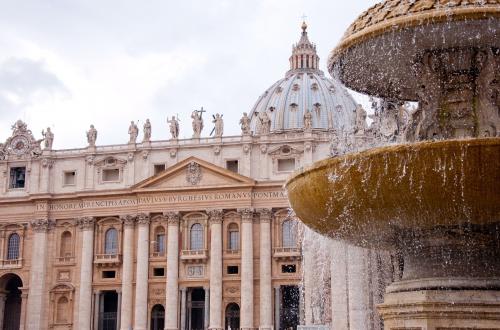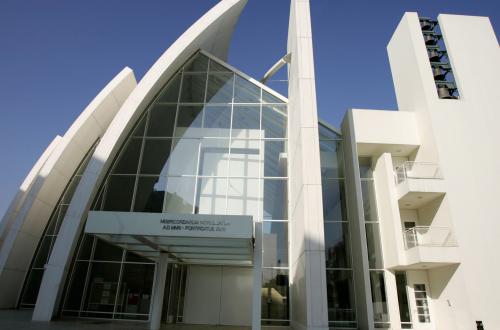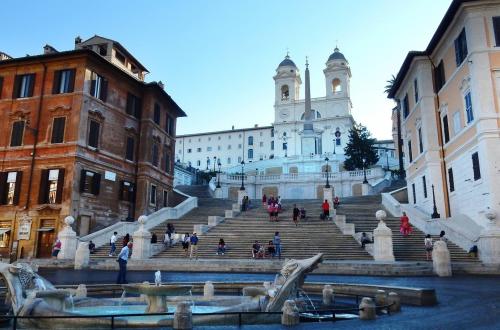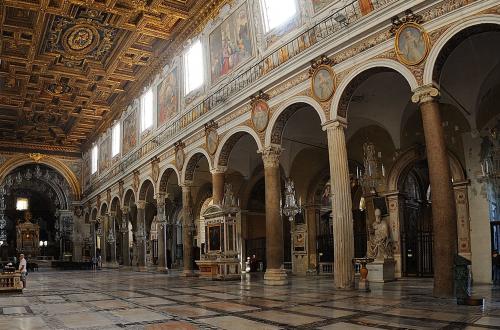Vatikanische Basilika St. Peter

 Condividi
Condividi
The church was started in 1643 on the initiative of Camilla Virginia Savelli Farnese and left unfinished until 1646; it was completed by other architects with variations on the initial design.
The history of the parish community has its roots at the beginning of the last century.
A church that welcomes everyone, in the heart of Mostacciano It wants to be an open Church, without fences and prejudicial boundaries, capable of welcoming inside but above all of going out, always
[...]The church of Santa Maria del Carmine and San Giuseppe al Casaletto is a church in Rome, in the Gianicolense neighborhood, on Via del Casaletto.
It is said that in 1546 tears flowed from the image of the Madonna frescoed on a wall of the portico of Octavia on the occasion of a crime committed in front of it.
First settlement in the area in 1969; the parish of reference is S. Pier Damiani until October 27, 1985. From 1977 to September 1981 the Holy Mass is celebrated in private places.
HistorySanta Maria del Popolo is one of the most significant buildings of the Roman Renaissance, not only for its architectural features, but also for the paintings and sculptures
[...]The church in Piazza Madonna di Pompei is entrusted to the care of the Missionaries of the Fraternity of St Charles Borromeo.
The church was built in the early 20th century and completed between 1912 and 1916 in neo-Gothic style by architect Giuseppe Ribaldi.
This church, which stands on land formerly belonging to the Municipality of Rome, was inaugurated on 24 September 1938, after about a year of work directed by engineer Francesco Fornari.
The church was built by the Confraternita del Suffragio, the intention being to establish a place where people could pray for the souls of those who had died.
Santa Maria della Concezione (Egyptian Arabic: كنيسه سانتا ماريا ديلا كونسيزيونى فى كامبو مارزيو) is a church in Rome, located on Piazza Campo Marzio in the Campo Marzio rione.
[...]The Church of Santa Maria della Consolazione is a church in Rome, in Via Aldo Della Rocca, in the Tor de' Cenci area.
Parish of Santa Maria della Fiducia located in the Finocchio suburb of Rome.The parish was erected on 1 July 1954 and entrusted to the diocesan clergy of Rome - Oblates Sons of Our Lady of Divine L
[...]The church of Santa Maria della Luce is an ancient church in the Rione of Trastevere in Rome, Italy.
The church is a parish seat, established by Pius XI on February 2, 1932 with the apostolic constitution In Salaria huius almae Urbis; originally the parish was located in the church of Santa Maria
[...]The church of Santa Maria della neve (ad nives) is located in Via del Colosseo, at the junction with Via del Cardello.
Prelatic Church of Opus Dei, it houses the remains of Josemaria Escrivà.
The small church is inserted in one of the fornixes of the Flavian amphitheatre; it already existed, as a sacred aedicule, at the time of Pope Paul IV (1555-1559). Armellini recounts that:
The complex is located on the via di Torrevecchia in the Primavalle district, overlooking a road raised above the ground that slopes down towards Fosso Mimmoli.
The Church of Santa Maria della Speranza is a church in Rome, in the Nuovo Salario district, in Piazza A.. Fradeletto.
It was built between 1965 and 1971 based on a design by architect Saverio Busiri Vici, and consecrated on October 22, 1971 by Monsignor Ugo Poletti.
The parish was erected on 13 August 1941 by decree of Cardinal Vicar Francesco Marchetti Selvaggiani ‘Beatissimae Virginis Gratiarum’ and entrusted to the diocesan clergy of Rome.
Santa Maria delle Grazie alle Fornaci fuori Porta Cavalleggeri is a Baroque style, Roman Catholic parish and titular church located at Piazza di Santa Maria alle Fornaci, south of Vatican City and
[...]Modernist art style church
The parish of Santa Maria Domenica Mazzarello is a church in Rome located in the Don Bosco neighborhood.
The church of Santa Maria Goretti was built in 1954 by architect Tullio Rossi and consecrated by Monsignor Luigi Traglia on 15 May 1954.
It was built in 1935 by Ettore Molinario to meet the spiritual needs of all the workers on the then farm that gave rise to the village of Grottarossa.
The building, which is located inside Villa Borghese near Piazza di Siena, was commissioned at the end of the 18th century by Prince Marcantonio Borghese, both to satisfy his devotion to the Virgin
[...]
 Condividi
Condividi

 Condividi
Condividi

 Condividi
Condividi

 Condividi
Condividi